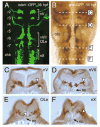Turning heads: development of vertebrate branchiomotor neurons
- PMID: 14699587
- PMCID: PMC2219919
- DOI: 10.1002/dvdy.10444
Turning heads: development of vertebrate branchiomotor neurons
Abstract
The cranial motor neurons innervate muscles that control eye, jaw, and facial movements of the vertebrate head and parasympathetic neurons that innervate certain glands and organs. These efferent neurons develop at characteristic locations in the brainstem, and their axons exit the neural tube in well-defined trajectories to innervate target tissues. This review is focused on a subset of cranial motor neurons called the branchiomotor neurons, which innervate muscles derived from the branchial (pharyngeal) arches. First, the organization of the branchiomotor pathways in zebrafish, chick, and mouse embryos will be compared, and the underlying axon guidance mechanisms will be addressed. Next, the molecular mechanisms that generate branchiomotor neurons and specify their identities will be discussed. Finally, the caudally directed or tangential migration of facial branchiomotor neurons will be examined. Given the advances in the characterization and analysis of vertebrate genomes, we can expect rapid progress in elucidating the cellular and molecular mechanisms underlying the development of these vital neuronal networks. Developmental Dynamics 229:143-161, 2004.
Copyright 2003 Wiley-Liss, Inc.
Figures


Similar articles
-
Identification of Phox2b-regulated genes by expression profiling of cranial motoneuron precursors.Neural Dev. 2008 Jun 19;3:14. doi: 10.1186/1749-8104-3-14. Neural Dev. 2008. PMID: 18565209 Free PMC article.
-
Slit and Netrin-1 guide cranial motor axon pathfinding via Rho-kinase, myosin light chain kinase and myosin II.Neural Dev. 2010 Jun 22;5:16. doi: 10.1186/1749-8104-5-16. Neural Dev. 2010. PMID: 20569485 Free PMC article.
-
Development of branchiomotor neurons in zebrafish.Development. 1997 Jul;124(13):2633-44. doi: 10.1242/dev.124.13.2633. Development. 1997. PMID: 9217005
-
Conservation of neuroepithelial and mesodermal segments in the embryonic vertebrate head.Acta Anat (Basel). 1993;148(2-3):110-23. doi: 10.1159/000147530. Acta Anat (Basel). 1993. PMID: 8109194 Review.
-
Moving cell bodies: understanding the migratory mechanism of facial motor neurons.Arch Pharm Res. 2007 Oct;30(10):1273-82. doi: 10.1007/BF02980268. Arch Pharm Res. 2007. PMID: 18038906 Review.
Cited by
-
Expression of Isl1 during mouse development.Gene Expr Patterns. 2013 Dec;13(8):407-12. doi: 10.1016/j.gep.2013.07.001. Epub 2013 Jul 29. Gene Expr Patterns. 2013. PMID: 23906961 Free PMC article.
-
Motor neuron migration and positioning mechanisms: New roles for guidance cues.Semin Cell Dev Biol. 2019 Jan;85:78-83. doi: 10.1016/j.semcdb.2017.11.016. Epub 2017 Nov 14. Semin Cell Dev Biol. 2019. PMID: 29141180 Free PMC article. Review.
-
The continued importance of comparative auditory research to modern scientific discovery.Hear Res. 2023 Jun;433:108766. doi: 10.1016/j.heares.2023.108766. Epub 2023 Apr 6. Hear Res. 2023. PMID: 37084504 Free PMC article. Review.
-
olig2-Expressing hindbrain cells are required for migrating facial motor neurons.Dev Dyn. 2012 Feb;241(2):315-26. doi: 10.1002/dvdy.23718. Dev Dyn. 2012. PMID: 22275004 Free PMC article.
-
The atypical cadherin Celsr1 functions non-cell autonomously to block rostral migration of facial branchiomotor neurons in mice.Dev Biol. 2016 Sep 1;417(1):40-9. doi: 10.1016/j.ydbio.2016.07.004. Epub 2016 Jul 6. Dev Biol. 2016. PMID: 27395006 Free PMC article.
References
-
- Abadie V, Champagnat J, Fortin G. Branchiomotor activities in mouse embryo. Neuroreport. 2000;11:141–145. - PubMed
-
- Abadie V, Morisseau-Durand MP, Beyler C, Manach Y, Couly G. Brainstem dysfunction: a possible neuroembryological pathogenesis of isolated Pierre Robin sequence. Eur J Pediatr. 2002;161:275–280. - PubMed
-
- Ando H, Furuta T, Tsien RY, Okamoto H. Photo-mediated gene activation using caged RNA/DNA in zebrafish embryos. Nat Genet. 2001;28:317–325. - PubMed
-
- Appel B, Korzh V, Glasgow E, Thor S, Edlund T, Dawid IB, Eisen JS. Motoneuron fate specification revealed by patterned LIM homeobox gene expression in embryonic zebrafish. Development. 1995;121:4117–4125. - PubMed
-
- Barrett C, Guthrie S. Expression patterns of the netrin receptor UNC5H1 among developing motor neurons in the embryonic rat hindbrain. Mech Dev. 2001;106:163–166. - PubMed
Publication types
MeSH terms
Grants and funding
LinkOut - more resources
Full Text Sources
Molecular Biology Databases

